And then there were two ... NFL teams in Los Angeles. The Chargers are moving north, the team announced today, and will eventually share a stadium with the Rams in Inglewood. Until that venue opens, probably in 2019, the Chargers will play at the 30,000-seat StubHub Center in Carson.
- Plaschke to Chargers: We. Don’t. Want. You.
- Elliott: Chargers’ move to L.A. is as unoriginal and uninspired as their new logo
- Hiltzik: Another reminder that it doesn’t pay for cities to do business with the NFL
- StubHub Center is the Galaxy’s world; the Chargers will just play in it
- The baseball angle: Why the Padres won’t become a power, even as the only game in town
- Share via
Clippers welcome the Chargers
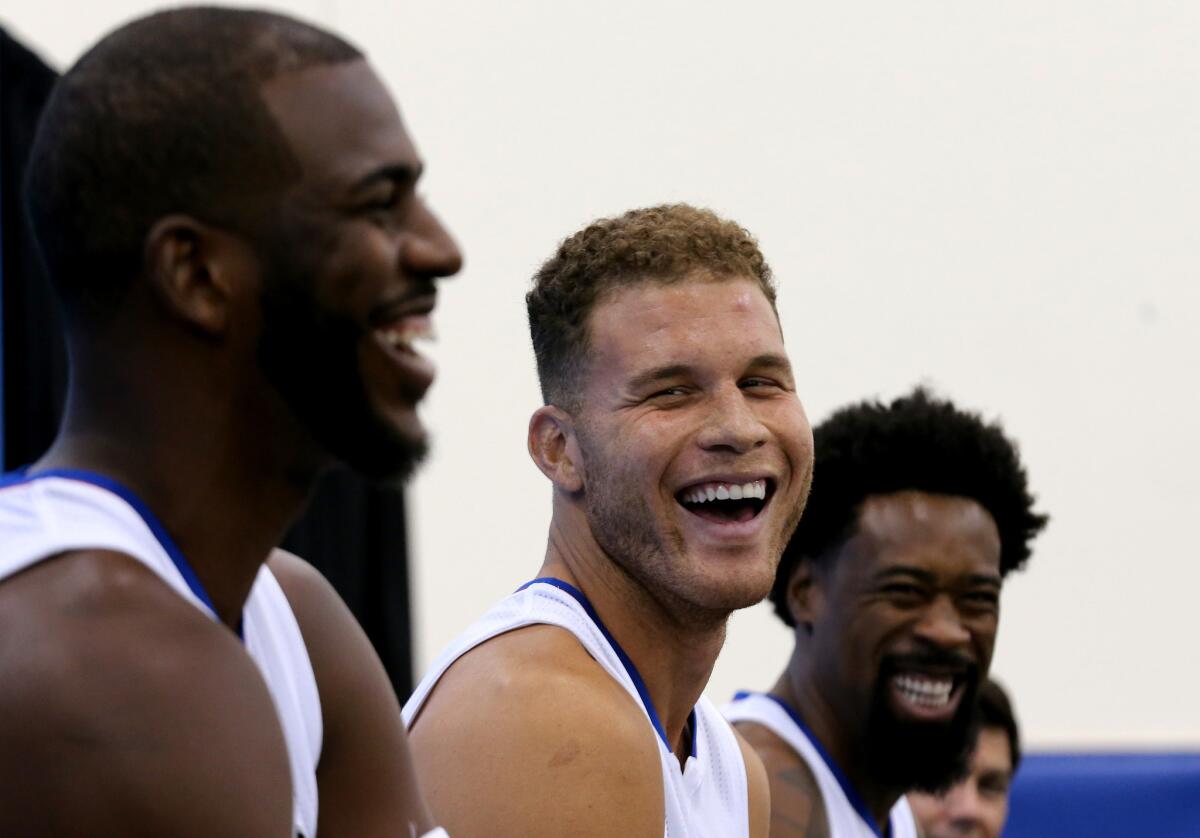
The Clippers recently have carved their own niche in the Los Angeles sporting landscape, selling out Staples Center 255 consecutive times with a star-studded group that includes Chris Paul, Blake Griffin, DeAndre Jordan and Coach Doc Rivers.
Now that the entertainment sports market in L.A. just got more crowded with the announcement Thursday that the San Diego Chargers were relocating to Los Angeles, the Clippers said that they “welcome” the area’s second NFL team.
“L.A. is a diverse, vibrant and sports-loving city that has continually shown the ability to support not just multiple sports teams but numerous entertainment options,” said Gillian Zucker, the Clippers’ president of business operations.
The Clippers actually have moved twice in the franchise’s history. The franchise originally began as the Buffalo Braves. They played in Buffalo from 1970-78 before moving to San Diego and becoming the Clippers. They resided in San Diego from 1978-84 before bolting to Los Angeles, where they have remained.
Chargers owner Dean Spanos announced his decision to move the team from San Diego to Los Angeles in a letter posted on the team’s website.
The Chargers had sought a new stadium in San Diego for the last decade, constantly looking for a place to move from the antiquated Qualcomm Stadium that was built in 1967.
Similar to the Clippers arrangement with the Lakers at Staples Center, the Chargers are expected to share the new stadium that the Rams are building in Inglewood.
The Chargers are supposed to play at the StubHub Center in Carson, the home of the MLS’ Galaxy, while the Inglewood stadium is being completed.
“We welcome the Chargers to Los Angeles,” Zucker said, “and believe that the NBA and the Steve Ballmer-led Clippers are a strong, world-renowned brand that will thrive and shine in any situation.”
- Share via
The Coliseum has been home to more than three teams in the past
If there were a hall of fame for stadium grounds crews, the 1960 Los Angeles Memorial Coliseum corps would have been selected on the first ballot. That year, the games almost never stopped at the stadium on 39th Street and Figueroa.
On Saturdays, either USC or UCLA played a home game there. On Sundays, the Rams and Chargers alternated playing games there. Throughout the summer and well into the football season, the Coliseum also hosted Dodgers games.
Even amid all this there must have been some down time, because John F. Kennedy accepted the Democratic Party’s nomination for president that same year from a lectern not far behind where the east goal posts stood during games.
If it had come down to it, the Coliseum today would have been plenty capable of hosting USC, the Rams and the Chargers, who announced on Thursday their relocation to Los Angeles.
So why will the Chargers play their games at the more intimate, less august StubHub Center in Carson, where the team gets second dibs on choosing game dates after Major League Soccer’s Galaxy?
It’s complicated, but let’s examine the situation:
USC manages the Coliseum under a lease agreement with the Coliseum Commission. In a statement a year ago, then-Athletic Director Pat Haden said the school’s “lease with the Coliseum Commission only allows one NFL team to play in the Coliseum at any given time.”
A second pro football team would require approval from three parties: USC, the California Science Center Board of Directors and the Coliseum Commission, which would first have to meet in public to discuss the proposal before voting on it.
Staffers from the science board and commission did not respond to requests for comment on Thursday, while a representative at USC declined to comment. Coliseum Commission President Mark Ridley-Thomas has said he had been in contact with the Chargers before the announcement of their move.
Sharing a stadium on Sundays is not easy, but it is doable. The New York Giants and Jets share MetLife Stadium in East Rutherford, N.J. They play on opposite schedules: When one plays at home, the other plays on the road.
But there were practical concerns to the Coliseum hosting a third football team. Before each USC or Rams game this season, crews blanketed the stadium with team logos, banners and advertisements on a scale much different than in 1960. Changing the stadium and the field required a small army of workers, which descended upon the Coliseum after each USC home game. Within hours, they’d begin repainting the field and end zones. A passerby on some Saturday evenings might have been confused why the West end zone was painted with “LOS USC.”
The field was always ready in time, despite some tight turnaround windows, but with double the games, the field’s grass took a beating.
The Chargers also might not have wanted to suffer the indignity of being the third-most-popular team in a two-NFL-team stadium. Last season, the Rams drew 74,121 fans on average in announced attendance. USC drew 68,459.
History suggests the Trojans might outdraw any local professional team next season if a nine-game winning streak is extended. USC’s most recent dynasty averaged more than 85,000 fans a game over five seasons, from 2004 to 2008. The StubHub Center’s capacity is about 30,000, roughly one third of the Coliseum’s.
And next season, USC is expected to be a playoff contender. Off-season moves are pending, but the general consensus is that the Chargers will not be a contender.
- Share via
Chargers to Los Angeles: Turf war with the Rams?
The Chargers are moving from San Diego to Los Angeles. Will there be a turf war with the Rams?
Gary Klein and Lindsey Thiry discuss the possibility.

The Chargers are moving from San Diego to Los Angeles. Will there be a turf war with the Rams? Gary Klein and Lindsey Thiry discuss the possibility.
- Share via
Chargers can learn from the Angels and L.A.’s Wrigley Field
When the Los Angeles Angels expansion franchise began in 1961, they played their home games at Wrigley Field, a 20,000-seat bandbox surrounded by homes at Avalon Boulevard and 42nd Place in South L.A.
Dodger Stadium was not yet ready. The Coliseum already had two tenants. And so little Wrigley Field was one-quarter full for the Angels’ third game there. The stadium was not quite one-half full for the Angels’ last game there.
In 2017, the Los Angeles Chargers will face a similar situation when they play their home games at the roughly 30,000-seat StubHub Center, at Avalon Boulevard and Victoria Street, 10 miles south of where Wrigley Field once stood.
After 1961, the Angels moved to the new Dodger Stadium and became their rivals’ tenants. Only after four more seasons did Anaheim Stadium open and the club’s move south to a stadium of its own occur. Only after another decade did they draw formidable crowds: 1978 was the first season they counted even half as many fans through the turnstiles as the 3 million they’ve claimed for 14 consecutive seasons now.
And it took until 2002 for the expansion franchise to win its first playoff series. The Angels won more playoff series that year — three, while winning a World Series — than in the rest of their history to date.
As the Angels learned, it takes enormous time to build an audience and win while new in this city. The Chargers have opted to test their findings.
- Share via
Chargers are gone, but hockey’s Gulls remain a pro sports choice in San Diego
The Chargers’ move to Los Angeles leaves the baseball Padres as San Diego’s only major league sports team, but they’re not the only professional team in town.
The San Diego Gulls of the American Hockey League — the Ducks’ primary farm team in the NHL’s top developmental league — have been making a strong impression since they were established in San Diego last season as part of the AHL’s new Pacific division.
The Gulls, who play in the Valley View Casino Center, averaged a solid 8,675 fans per game last season to rank second in the NHL. They advanced to the playoffs and lost in the second round to the Ontario (Calif.) Reign, the Kings’ top farm team. The Gulls rank third in AHL attendance this season at 7,975, behind Hershey (Pa.) and defending champion Cleveland.
Matt Savant, the Gulls’ president of business operations, issued a statement Thursday expressing the club’s sorrow about the Chargers’ departure.
“We join the San Diego community in sadness today as we learn of the departure of the Chargers,” he said. “Since moving to San Diego 50-plus years ago, the Chargers have been an incredible asset to San Diego and built a strong foundation to help critical causes important to our region through sports and community involvement. San Diego will remain a strong and passionate community and we are thrilled to continue our dedication to represent the loyal and devoted fans of this city.”
Gulls Coach Dallas Eakins also shared his thoughts, via Twitter:
- Share via
Chargers’ move to L.A. is just like their new logo: unoriginal and uninspired
One look at the logo of the new Los Angeles Chargers tells you all you need to know about owner Dean Spanos and his motives in moving the team. It’s unoriginal and uninspired, just like his decision to uproot the Chargers from their longtime home and flee northward to escape paying for a new stadium in San Diego.
Using a color that’s suspiciously close to Dodger blue, Spanos and the Chargers are blatantly trying to capitalize on the popularity and goodwill the Dodgers have generated over decades in Los Angeles. The Chargers’ stylized, interlocked letters “LA” look more like an accidentally electrocuted Dodgers logo than the symbol of an electrifying football team, which the Chargers haven’t been lately and surely won’t be for a while.
Funny, too, that the video they’ve posted on Facebook proclaims, “In 2017 the Chargers are bringing the fight to Los Angeles.” Fight for what, other than fans’ dollars? The NFL seems to view Los Angeles as a gigantic, personal ATM and has allowed the Rams — and now the Chargers — to migrate here to make large and frequent withdrawals from fans’ wallets. At some point the well is going to run dry, not only financially but emotionally, too.
- Share via
Chargers in StubHub Center? What’s wrong with the Rose Bowl?
It’s just too bad the Chargers are going to be stuck with a view of Carson’s urban sprawl for the next two years when they could be looking at a glorious Arroyo Seco sunset.
Sure, it’s not their fault that the Rose Bowl Operating Co. has treated NFL requests for a proposal to temporarily host a team as if its being asked to house the homeless.
But this is a lose-lose proposition for all involved.
Going from Qualcomm Stadium to StubHub Center, even if the move is only temporary, is like going from an aging three-bedroom condominium to a newish studio apartment.
StubHub Center, with its 27,000 seats, is adequate for Major League Soccer, high school football games and other second-tier events. Even with enhancements and added seating, the place does not feel worthy of the NFL.
Then there’s the Rose Bowl, which is only the most breathtaking venue in college football, if not all of sports. It has the seating capacity, the necessary luxury suites and the infrastructure that a facility less than half its size can’t match. More important, it has the feel of big-time football.
StubHub Center has the feel of Mater Dei High versus Corona Centennial.
Dodger Stadium would have been better. So would Angel Stadium. Maybe even Staples Center with a modified Arena Football League configuration (assuming it could house an NFL-sized field) would be preferable.
The Chargers going to the Rose Bowl while the Rams remained in the Coliseum would have allowed the teams to become the NFL’s version of UCLA versus USC. The Rams might have set foot in the Rose Bowl and felt a twinge of jealousy.
Now they’ll arrive at StubHub Center and be tempted to laugh.
- Share via
StubHub Center: It’s the Galaxy’s world, Chargers will just play in it
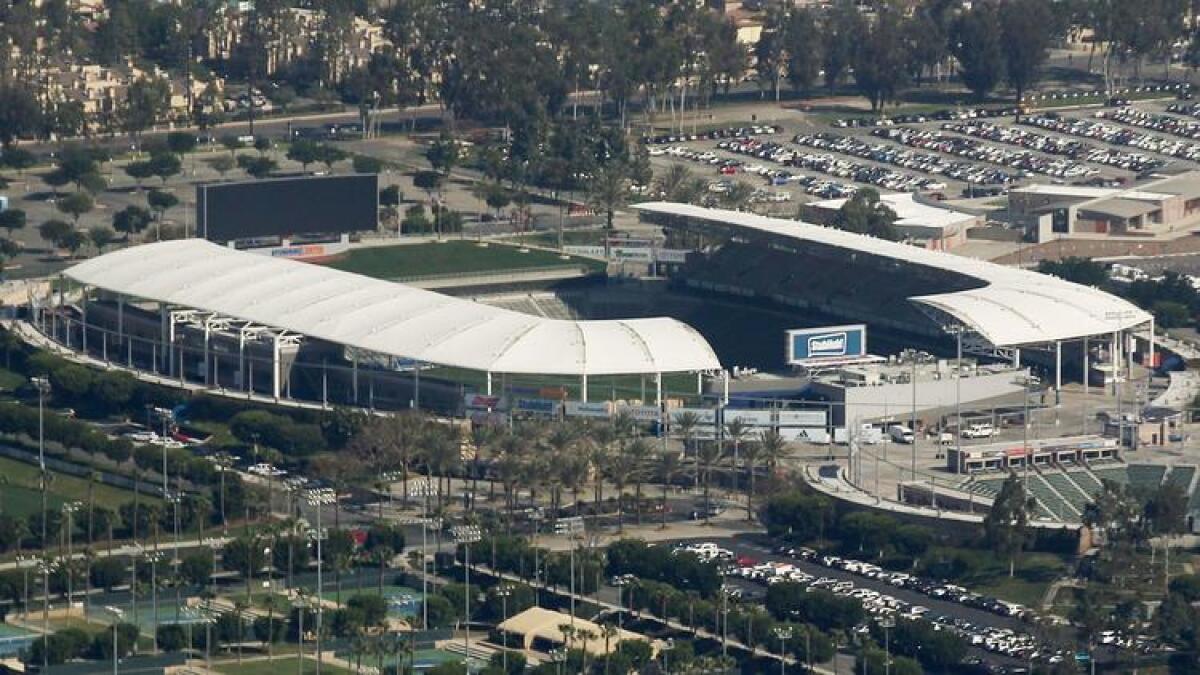
Although the Chargers will call StubHub Center home the next two seasons, Major League Soccer’s Galaxy will remain the stadium’s main tenant.
“The Galaxy is the main priority for StubHub Center,” said Brendan Hannan, director of communication for the facility. “The Chargers’ NFL schedule will be built around the Galaxy schedule. The same will happen in terms of 2018.”
The MLS schedule was to be released Thursday afternoon. Last season the team played few Sunday home games.
The Galaxy will be one of six MLS teams to share its stadium with a professional football team next season, although StubHub Center is the only one with a grass field.
- Share via
Kings’ Nick Shore on the Chargers’ move: Can’t wait for the Broncos to come to town
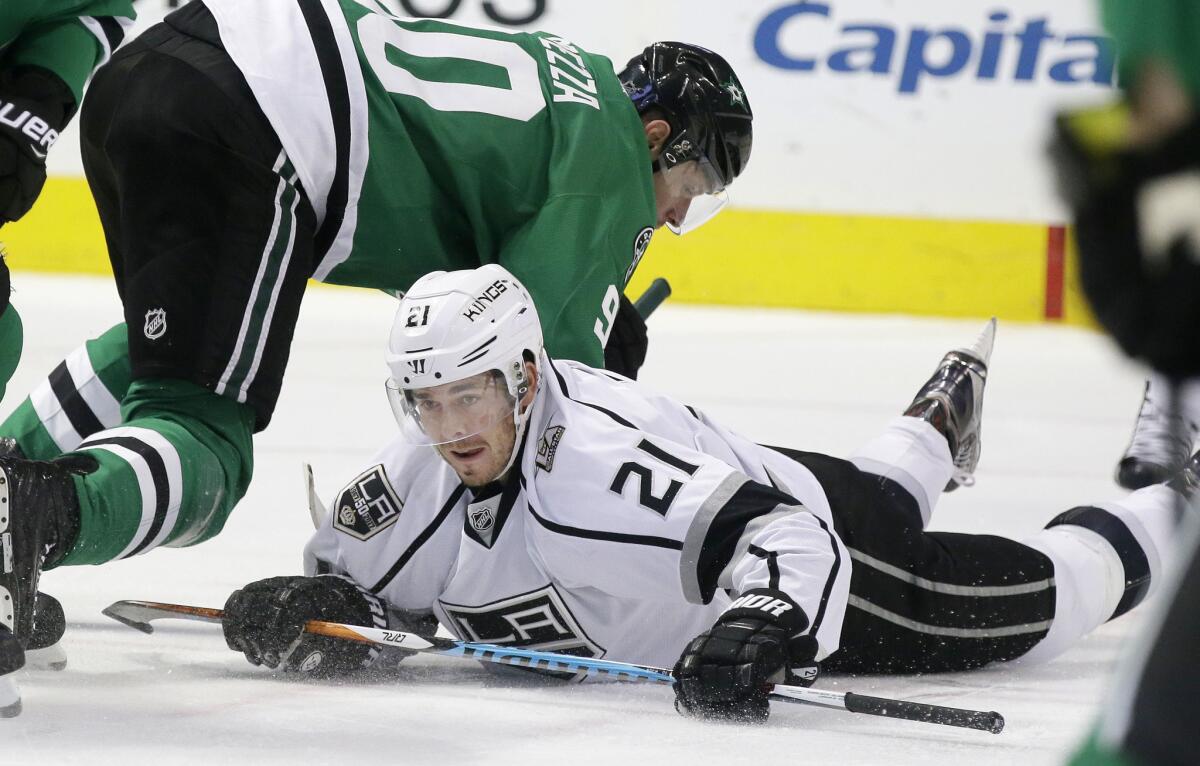
There may be small groups of the Los Angeles football community rejoicing Thursday: Transplanted fans of the Denver Broncos, Kansas City Chiefs and Oakland Raiders who will get to see their teams visit the Chargers for AFC West action.
Count Kings forward Nick Shore among them. Shore, who is 24 and from Denver, is a lifelong Broncos fan. He didn’t think much of the Chargers’ officially announcing their move to L.A. on Thursday morning, but is excited to see his hometown team come through town.
“The big positive for me is that the Broncos will be coming every year and it will be cool to see them,” Shore, who has four goals and four assists this season, said Thursday morning. “And if they play the Rams, then they will come twice. That would be cool. Other than that I don’t know enough about the fan base or anything to know if it will work out for the Chargers. We’ll see.”
Shore and a handful of his teammates attended the Rams’ home opener against the Seattle Seahawks at the Coliseum in September. He said he found it to be a fun atmosphere and that he would go back.
But a Chargers game? That’s enemy territory.
If Shore does attend the Chargers’ home opener — they announced a plan to play at the L.A. Galaxy’s StubHub Center in Carson for the next two seasons — he will most certainly be wearing his Broncos gear.
“Von Miller, baby,” Shore said, smiling, of his go-to jersey. “That’s my favorite player.”
- Share via
San Diego mayor says Chargers will regret moving to L.A.
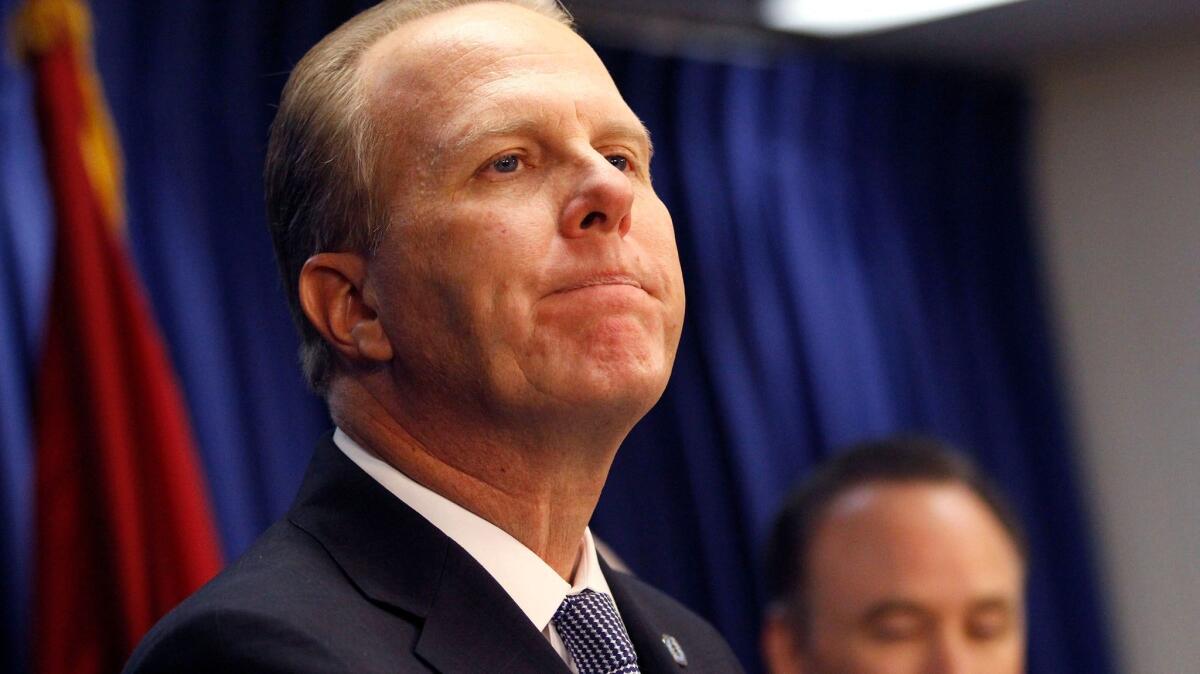
San Diego Mayor Kevin Faulconer said he was frustrated that the Chargers announced Thursday morning that they will move to Los Angeles after 56 years in San Diego, and he predicted the team would regret the decision.
Faulconer said at a City Hall news conference that the Chargers wanted local taxpayers to chip in too much money for a new stadium.
“Dean Spanos made a bad decision and he will regret it,” said Faulconer, who endorsed the team’s unsuccessful stadium ballot measure last fall. “San Diego didn’t lose the Chargers, the Chargers just lost San Diego.”
He also predicted the Chargers would never get the support in Los Angeles that they’ve enjoyed in San Diego or have the same kind of success.
- Share via
Don’t expect a big economic boost with the Chargers’ move to Los Angeles
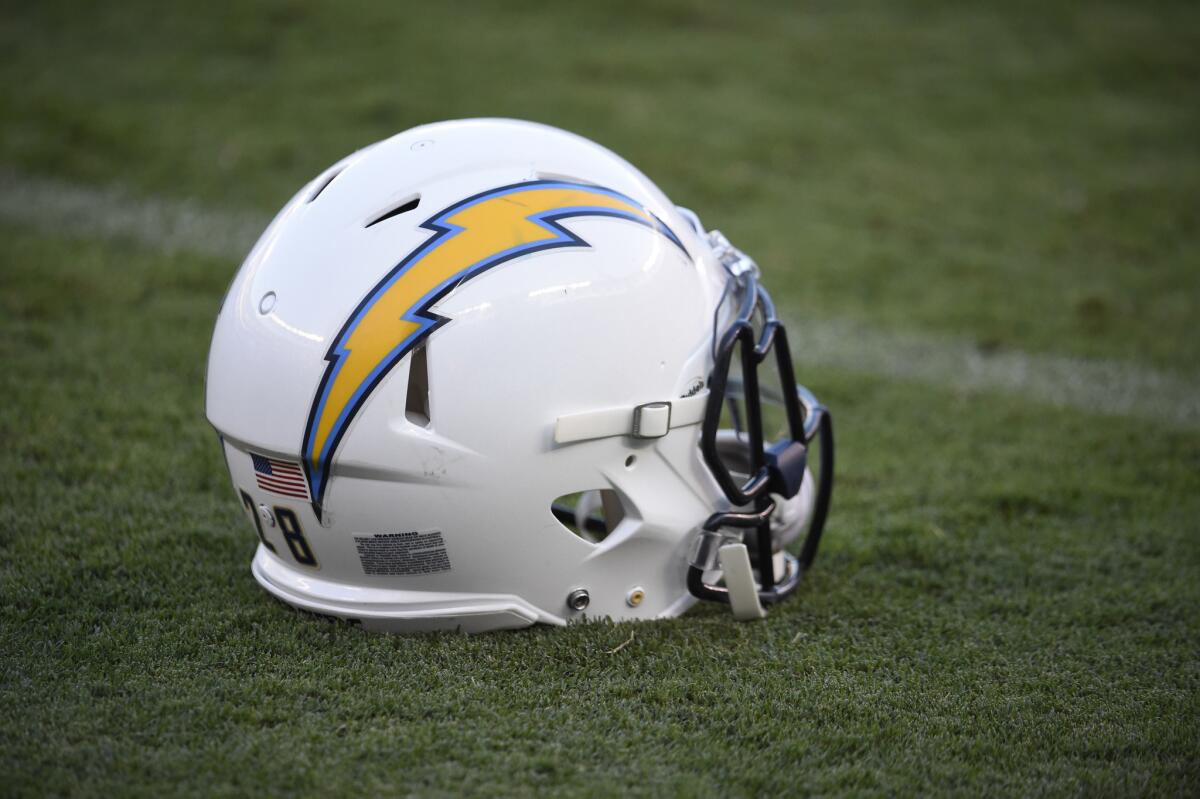
A second NFL team soon will call Los Angeles home, but sports economists say the addition of the Chargers might not necessarily provide an economic boost for the area.
L.A. already is a crowded sports market — two NBA teams, an NHL team, a WNBA team, an MLB team, an MLS team — as well as the Rams, which just returned to the city last year. And sports economists say there’s only a certain amount of dollars that will go toward sporting events and merchandise.
“From a traditional consumer standpoint, I think any real impact is going to be very modest,” said David Carter, executive director of the USC Marshall Sports Business Institute and principal at the Sports Business Group consulting firm. “It’s really going to be a transferring of spending that is already taking place in the region.”
The same could be true on the corporate spending side, as high-end boxes and suites for Chargers games might simply be transferred over time from similar arrangements at Dodgers Stadium or Staples Center, he said.
Game attendance for two NFL teams over a season was projected at more than 1.3 million, according to a 2015 study by the Los Angeles Economic Development Council, which analyzed the economic impact of an NFL stadium in Carson.
That study was commissioned by the Oakland Raiders and the San Diego Chargers.
Team and stadium operations spending by those two franchises was estimated at $470 million for 2015, according to the report.
But the L.A. teams’ losing records — 5-11 for the Chargers last season and 4-12 for the Rams — don’t help attendance and merchandise sales.
“Winning is certainly going to be critical,” Carter said. “And I think the Rams were reminded of that this season.”
- Share via
Join us to discuss the Chargers’ move from San Diego to Los Angeles
- Share via
Every city should be wary of doing business with the NFL
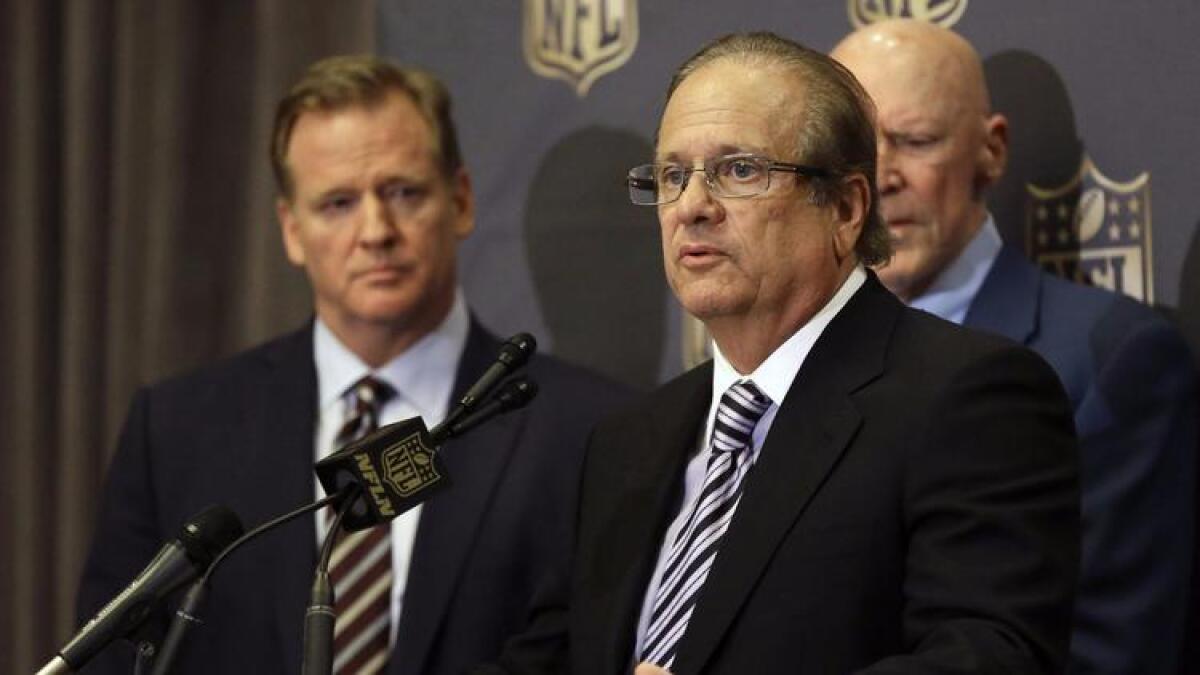
There isn’t much more to say about the San Diego Chargers’ move to Los Angeles other than: “We told you so.”
For years, we’ve been documenting how cavalier the National Football League and its franchises can be when its member billionaires’ quest for public money trumps such family values as loyalty and tradition. We’ve shown that, when threats to relocate turn into reality, you can count on the billionaires to shed crocodile tears for the fans they’re leaving behind, while pledging eternal fealty to their new marks.
- Share via
Here’s how we covered the L.A. Chargers back in the ‘60s
- Share via
Current and former Chargers react to the relocation news on social media
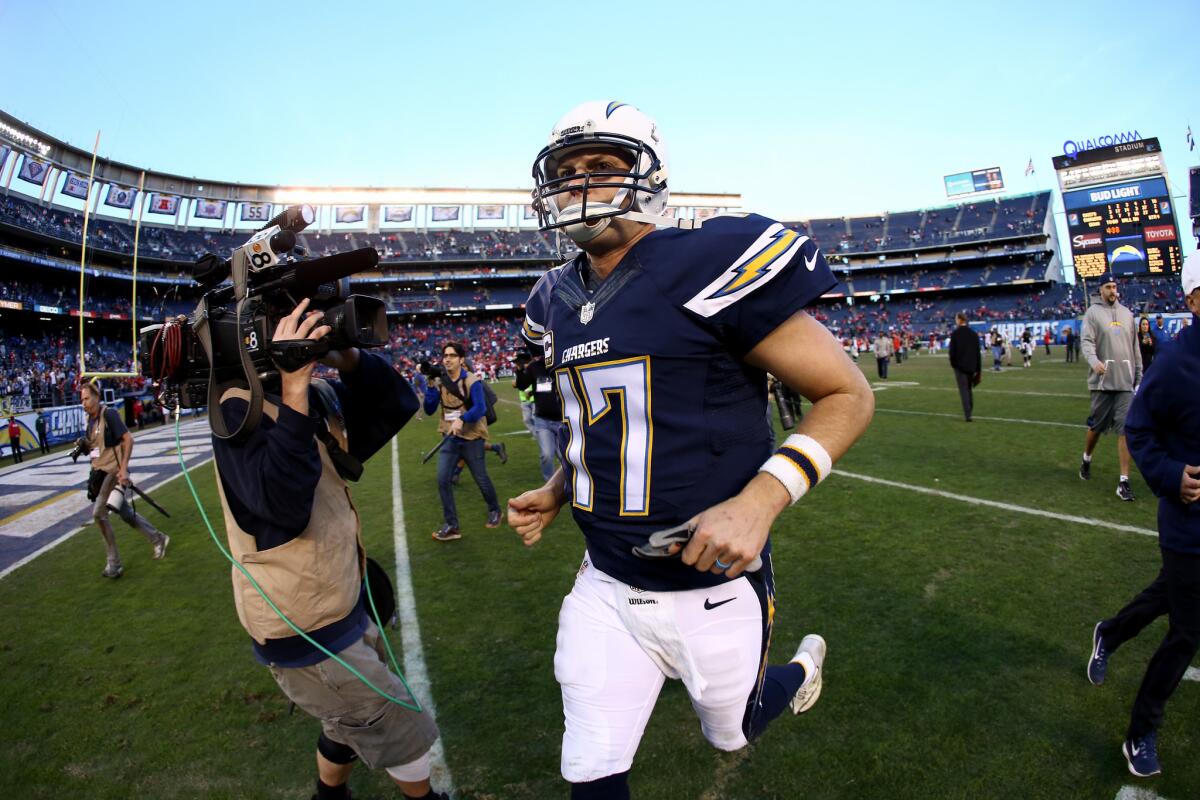
- Share via
Well, there is at least one team not moving to L.A.
- Share via
Dodgers Manager Dave Roberts on Chargers’ move: ‘As a fan and a San Diego native, it’s disappointing’
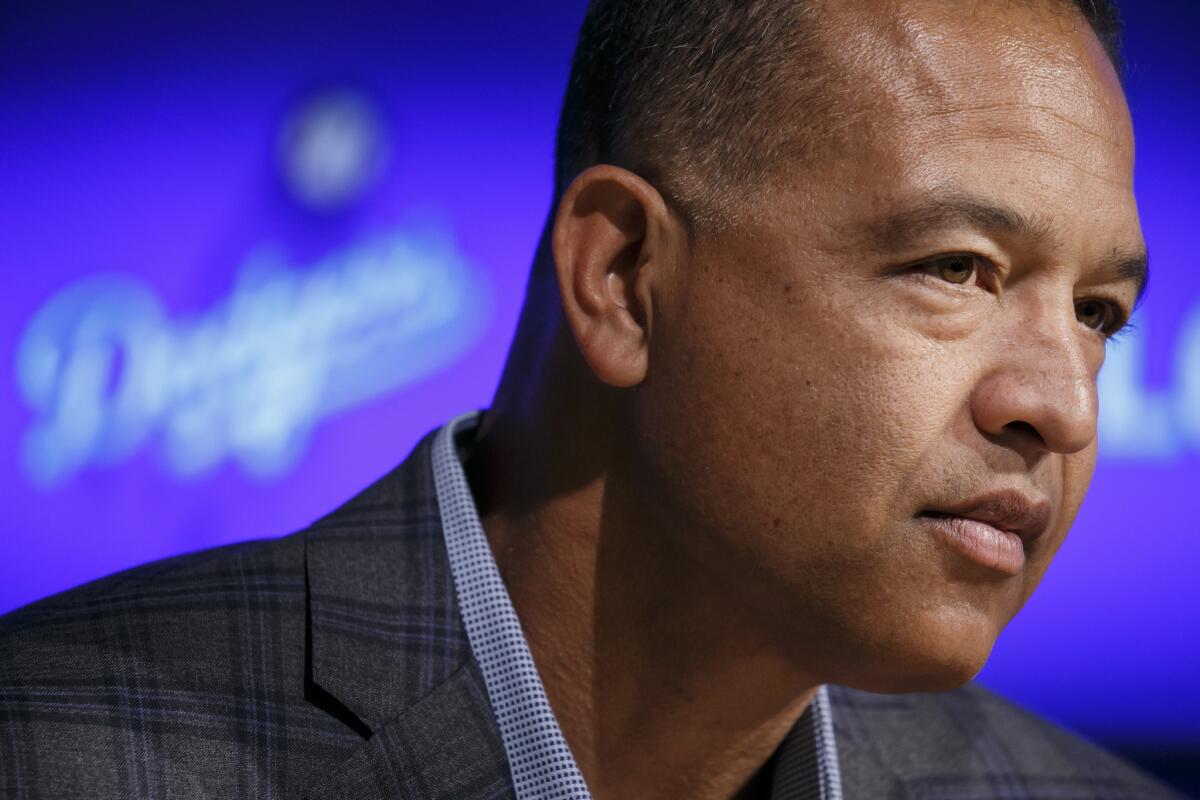
Dave Roberts moved to San Diego in 1984 and called the city home during a baseball career that has carried him across the country. He played and coached for the Padres. He rooted for the Chargers, developing an affinity for stars like Junior Seau and LaDainian Tomlinson.
Even now, as manager of the Dodgers, he still lives in San Diego County during the off-season. So he settled on an understandable refrain Thursday morning, when the Chargers officially announced their departure from San Diego for Los Angeles. The word “disappointing” came up often as he discussed the move with The Times.
“For me, as a part of the community, for the franchise itself, it’s just very disappointing that it would have to come to this,” Roberts said in a telephone interview. “Because it seems like moving shouldn’t have been an option. But obviously the Spanos family has their reasons.”
Chargers owner Dean Spanos announced the move in a letter on his team’s website. Spanos had spent more than a decade negotiating with the city of San Diego about finding a replacement venue for Qualcomm Stadium, which was built in 1967, six years after the Chargers left their original home at Los Angeles Memorial Coliseum and embarked south.
The Chargers are expected to share a stadium with the Rams in Inglewood. Rams owner Stan Kroenke moved the Rams out of St. Louis last winter. While the new stadium in Inglewood is being built, the Chargers are expected to play at the StubHub Center in Carson, the home of the MLS’ Galaxy.
Meanwhile, San Diego, the eighth-largest city in America, will be left with a lone sports franchise, the perpetually bottom-dwelling Padres.
“As a fan and a San Diego native, it’s disappointing,” Roberts said, “because you associate the Chargers as our hometown team. But I think if there’s any city that can handle and support two NFL teams, Los Angeles certainly is a city.
“Selfishly, me living up in Los Angeles, it makes it easier for me to see the Chargers. But as a San Diego native, it certainly is disappointing that a city like this, at any point in time, wouldn’t have an NFL team.”
- Share via
Chargers’ exit leaves an empty stadium full of memories
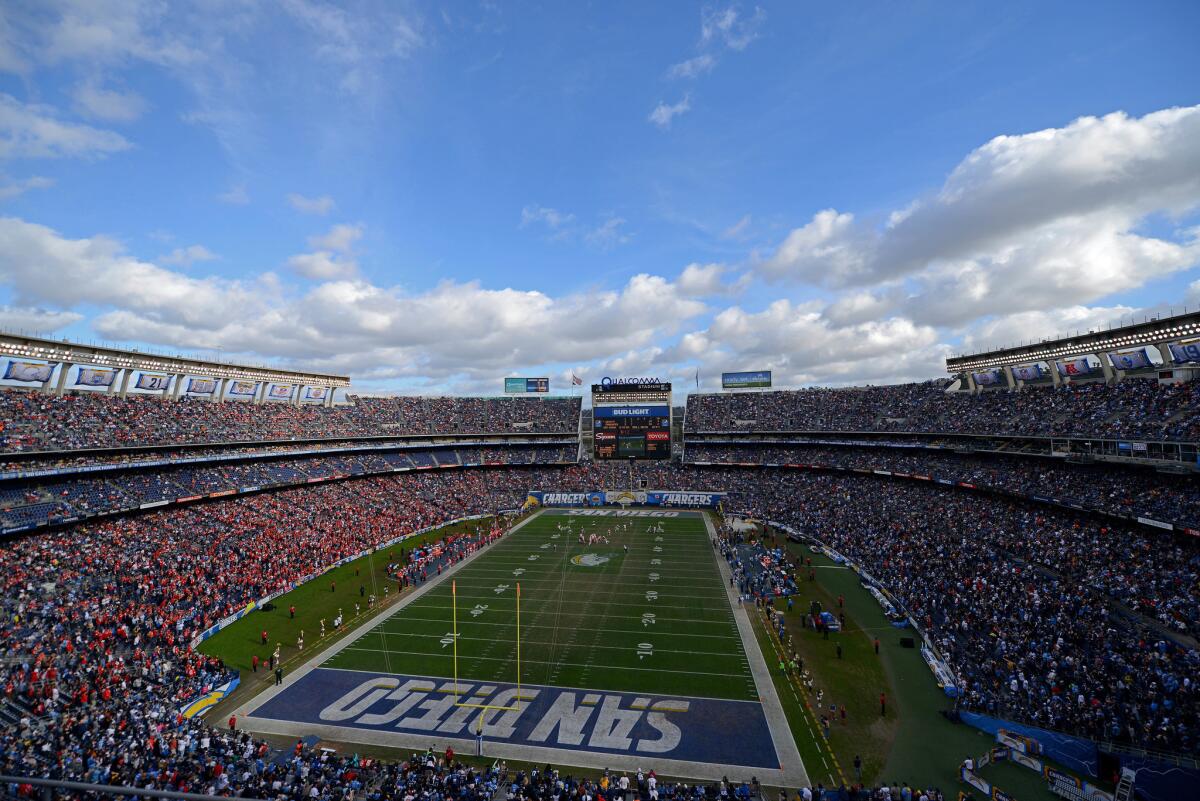
With the Chargers relocating from San Diego to Los Angeles, it’s the end of an era for a stadium that, despite increased ridicule since it hosted its third Super Bowl in 2003, served as a second home to myself and thousands of others who’ve resided in “America’s Finest City.”
Those who weren’t raised in the seats of Qualcomm Stadium have dismissed it as an unsightly, concrete, cookie-cutter, multi-purpose venue that — without enough suites — is outdated and out-used by NFL standards.
They’re right, but let me tell you what a delight it was to wear the place out.
In 1967, the same year that San Diego Stadium opened for business, my parents brought me home from the hospital to our cul-de-sac home off Mission Village Drive, a road that feeds into the stadium.
My grandpa, a gas station owner, was one of the original Chargers’ season-ticket holders, and he brought me along at age 7 to my first game against a team he told me we hated, the Oakland Raiders.
Wearing a new Chargers’ No. 74 jersey to befit the year, I held my grandpa’s hand up the escalator to our press-level seats.
There, on a typical cloudless San Diego afternoon, Ken Stabler, John Madden and Co. got the best of us, proving the Raiders were worth our disdain. That point was later underlined by Stabler’s famed “Holy Roller” play in the stadium a few years later, and a touchdown pass from Jim Plunkett in the 1980 AFC Championship game that was deflected off a silver-and-black helmet.
By 1984, I left my high-school job early so I could race down Interstate 8 to watch the San Diego Padres’ first home playoff game against the Chicago Cubs in the National League Championship Series.
The Pads had been so bad for so long that the game had the feel of a champagne cork being popped for fans, whose cheers I could hear at introductions while running up the stadium’s signature concrete circular ramps to my seat alongside my brother and dad.
As I rushed through the concourse, I stopped at one aisle to see Padres shortstop Garry Templeton being introduced, waving his hat to the fans to further encourage the enthusiasm that helped the team not only win that game, but three straight to make the World Series.
After Kurt Bevacqua homered to win the team’s only World Series victory, he blew a two-handed kiss toward our direction in seats by the third-base line.
By 1994, I could afford my own season tickets, and my dad, brother and I had seats behind the east end zone, where visiting fans would sometimes sneak in.
What a joy it was telling a mullet-wearing yahoo from Kansas City in front of me to hit the road after Stan Humphries and Junior Seau paced a win. It was in these seats that we saw Miami’s Pete Stoyanovich miss a field goal wide right that allowed the Chargers to escape with a 22-21 playoff victory.
A week later, on the night of Jan. 15, 1995, we attended the euphoric celebration following the 17-13 AFC Championship win at Pittsburgh with about 75,000 squeezed into the stadium.
As the “San Diego Super Chargers” song blared, “Bring on the 49ers!” was posted on the big-screen message board.
Be careful what you wish for.
In 2004, when The Times had assigned me to hard-news reporting and my children were 10 and 4, we started making treks back to the stadium with a new season-ticket experience that lasted six seasons.
The loss of community bonding not only during games but in tailgating is one hell of a punch to San Diego’s gut.
I recall one game in 2007 when then-Gov. Arnold Schwarzenegger appeared at midfield in a Chargers jacket to thank firefighters and volunteers who helped during a massive wildfire that left many homeless, ending the speech with a memorable, “Go, Chargers, Go!” shout.
During the national anthem, my family and I peered a section over and saw a grown man — certainly affected by the damage — with his face saturated in tears until he was comforted by a neighbor seated a row below him.
And there was some remarkable football during that time.
LaDainian Tomlinson entrenched himself as the best Charger of all, an inspiration who set the NFL season touchdown record and should’ve been used more by Coach Marty Schottenheimer in that especially painful 2006 playoff loss to Tom Brady and the Patriots.
If any of about seven things had happened in the Chargers’ favor that game — like Marlon McCree not fumbling an interception return or receiver Vincent Jackson getting both feet inbounds in the end zone — I’m convinced that would have been the year.
Instead, owner Dean Spanos allowed Schottenheimer to be fired after a 14-2 season and erratic focus under Norv Turner defused a talented roster that has been further diminished by injuries in recent seasons.
The uncertainty over relocation allowed the shameful scene of Raiders’ fans taking over the stadium last month to clinch a playoff spot.
Of course, if you’re a San Diegan, the sadder sight will be the empty stadium on NFL Sundays.
- Share via
High school coaches hope Rams and Chargers can make impact in L.A.
High school football coaches in Southern California are both optimistic but also a little skeptical about whether having the Rams and Chargers in Los Angeles will impact their programs in a positive manner.
Charles Mincy, the football coach at Dorsey and a former head coach at Inglewood, the city where the new stadium is being built to house the Rams and Chargers, said he’s taking a wait and see approach.
“It’s all based on how they handle it,” he said. “It’s based if they really reach out in the community and make an effort to do it. There’s a lot of high school programs that can use help. The inner city programs are suffering.”
The Rams have already made an effort after being gone for 22 years. With the help of former Dorsey and UCLA football player Johnathan Franklin in the Rams’ community outreach office, the Rams donated footballs, mouthpieces, jerseys, polos and soft shell helmets to 67 high school football teams in the Los Angeles Unified School District.
- Share via
Why Chargers’ departure for L.A. won’t make Padres a power, even as the only game in town
The Clippers bolted for Los Angeles, and now the Chargers have followed, more than 30 years later. The Padres are the lone major sports team left in San Diego, and the only Major League Baseball team that does not have to share its market with an NFL, NBA or NHL team.
Good for the Padres? Sure.
Can the Padres leverage their status as San Diego sports monopolists into a powerhouse franchise? Probably not.
In Petco Park, the Padres boast the best ballpark in Southern California, with the adjacent Gaslamp Quarter and a convenient train and trolley system enabling fans to come early, stay late and have fun.
- Share via
Lakers Coach Luke Walton: ‘I’m a Charger fan that wants the team in San Diego’
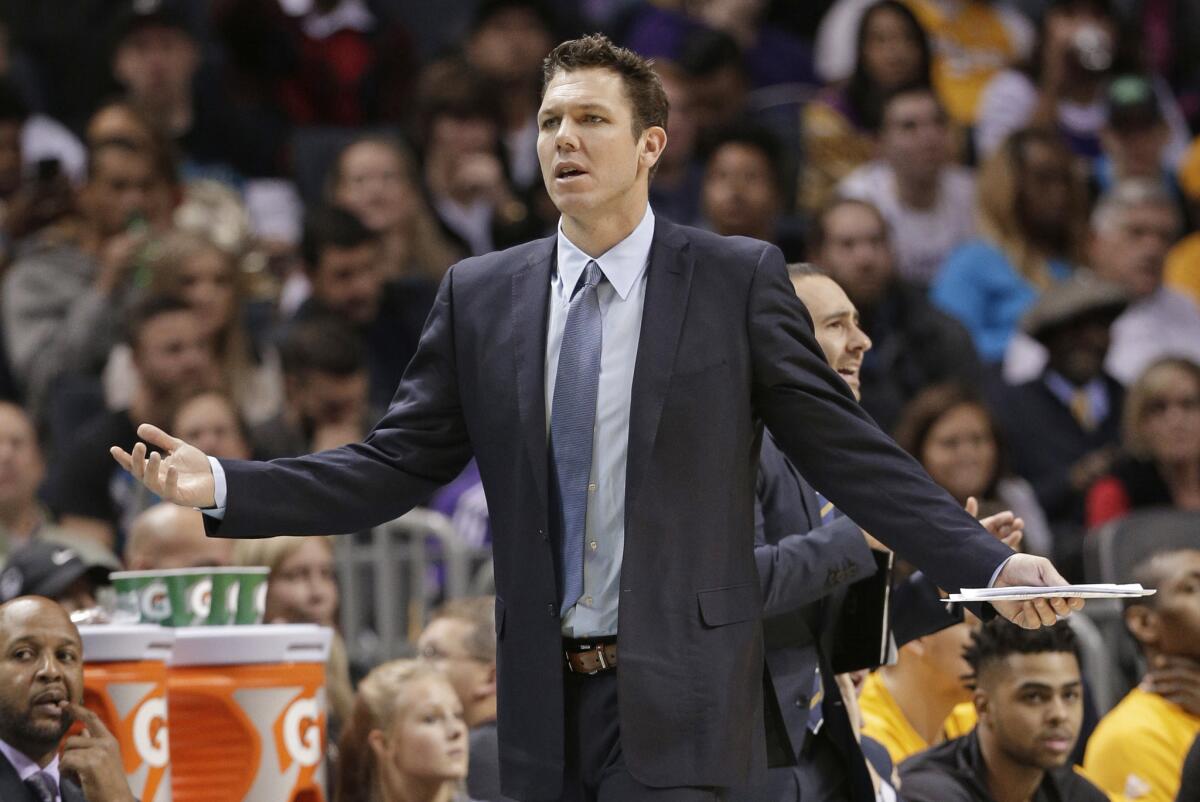
Someone had switched off the NFL game on the television in the locker room before the Lakers played the Nuggets in Ontario for a preseason game back in October.
So Lakers Coach Luke Walton resorted to the media dining area to watch his hometown San Diego Chargers play the Raiders.
“For me as a sports guy growing up there it was them or the Padres,” Walton said. “We have a loyal group of fans that were used to the tough times of trying to win, but we stuck with our team. They were a big part of growing up in San Diego.”
The Chargers lost to the Raiders that day, but losses have never tested Walton’s loyalty to the team he grew up supporting.
This move might.
After shootaround today, Walton was asked if he’ll be buying season tickets to see the Los Angeles Chargers.
“No, no,” he said quickly. “I’m a little heartbroken over it right now. I’m not ready to deal with the reality that they’re leaving San Diego.”
He simply reacts as a fan. Walton hasn’t followed the business machinations of what prompted this move, since he’s a little busy in his first season as an NBA head coach.
“I don’t think it is [the right move], but I’m a Charger fan that wants the team in San Diego,” Walton said. “I have no idea what’s happening on the business side of it but I obviously would like to have had them stay.”
- Share via
Dear San Diego, Here’s why not having an NFL team could be a good thing
Dear San Diego,
I was so sorry to hear the news about the loss of your NFL team. As you know, we recently lost our NFL team for about 20 years, but thankfully, the city of St. Louis saw our “Reward: Lost NFL team” poster and returned it to us.
In the meantime however, we had to learn how to cope without one. So here are some friendly tips for you.
1. You now will be able to watch a lot of good NFL teams play on the weekend, instead of watching the Chargers play.
2. Your chances of winning a Super Bowl championship have not changed whatsoever.
3. Instead of waiting until Mother’s Day, you can take mom out to brunch any Sunday of the year.
4. Good news if you have some errands to do around Qualcomm Stadium on the weekend: Traffic won’t be a problem.
5. No more worrying whether your team will miss the playoffs or lose in the first round.
6. That area to the west with all that water and sand? Those are called beaches. You can go there and relax.
7. No more worrying that your kid will say “Dad, I want to grow up and be a kicker like Rolf Benirschke.
8. No more trying to remember the name of the Chargers coach.
9. You can devote more time now to planning to visit the biggest event in town, San Diego Comic Con.
10. And last, but certainly not least, you don’t have to worry about Raiders fans coming to your city once a year.
Sincerely,
A Rams fan
- Share via
Chargers are on a fast track to irrelevance
The Chargers are headed toward Los Angeles, that much we know.
There are several things we don’t know, such as why owner Dean Spanos chose to leave what he acknowledged was a passionate fan base and head north at a relocation cost of $650 million, leaving behind not only those loyal fans but also $300 million the NFL would have paid for him to stay.
And here’s another question for him:
How do you plan on not becoming the Clippers?
It was in 1984 that the Clippers, who had been purchased three years earlier by a Los Angeles real estate developer named Donald Sterling, ended a futile six-year run in San Diego and started an even longer run of futility in L.A.
They had one winning season, their first, in San Diego, followed by 12 years of losing – their last five in San Diego and their first seven in L.A.
After that came one winning season, a .500 season, then another 12-year run of losing – including a 15-win season and a pair of 17-win campaigns. Not exactly the best way to ingratiate yourself to a new fan base.
The Chicago Cubs and Boston Red Sox had decades long championship droughts, but the Clippers became the poster franchise as the most hapless, perennial loser in professional sports.
Even this decade, with the additions of Chris Paul, Blake Griffin and DeAndre Jordan bringing two division championships, the Clippers remain far less popular than the Lakers, the team they have shared Staples Center with since 1999.
The Chargers also come to L.A. as losers – this season’s 5-11 record following a 4-12 campaign – but before that suffered only one losing season in 11 years, so there’s hope.
But L.A., which managed to survive quite nicely without an NFL team for more than 20 years, now suddenly has two. And the Chargers, like the Clippers, are the second team in and will be the second tenant in a shared stadium.
The big difference, of course, is that the Rams aren’t nearly as entrenched as the Lakers were.
Still, the Chargers face an uphill battle.
The advice here, to steal a phrase connected to the team many L.A. football fans would rather have here than the Chargers: Just win, baby. Fast.
Hire a smart, dynamic coach. Bring in talented, dynamic players. Do it now and you have a shot of catching the Rams while they’re down.
If not, you’ll have to hope that someday have a chance to make another move, one the Clippers probably should have made years ago – to Orange County.
There, the Angels won 74 games and finished 21 games back in the American League West last season. And still drew more than 3 million fans.
- Share via
Dean Spanos could have been a hero, but now he’s San Diego’s villain
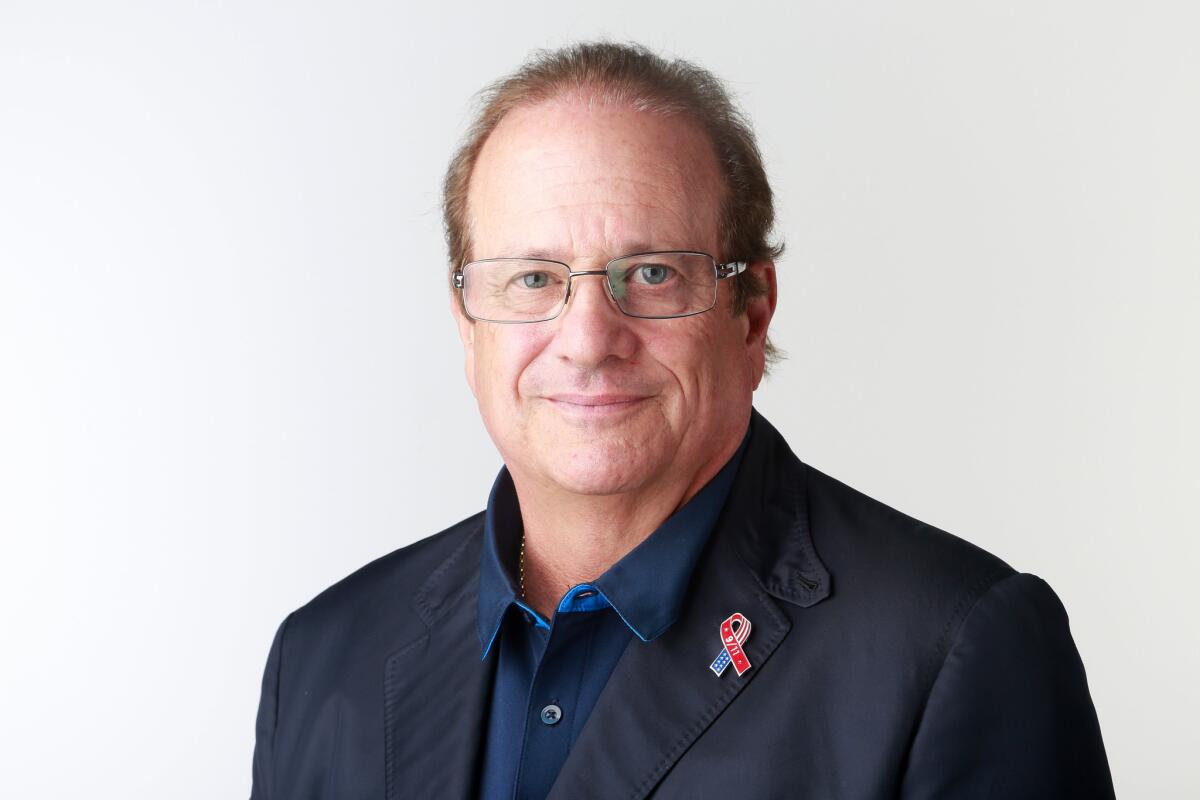
Dean Spanos did it.
He created a lasting legacy.
He is the most hated man in San Diego. Ever.
Perhaps we should be more appalled at a McDonald’s massacre or offended by a molesting mayor. Maybe the black eye of “Enron by the Sea” was worse.
- Share via
Chargers apparently devoted about five minutes to designing their new logo
You know that kid in high school who would wait until the last minute to do a book report, and then either copy the Cliffs Notes or cut and paste his report from Wikipedia? Well, that kid grew up and apparently designs logos for the Chargers now.
As everyone on Twitter and anyone who is a Dodgers fan immediately noticed, their new logo looks suspiciously familiar.
So, since the Chargers seem intent on copying things L.A. already has, here’s one word of advice: Don’t sign Dieter Brock to be your quarterback.
- Share via
Read Dean Spanos’ letter announcing the Chargers’ move to L.A.
- Share via
A few unhappy Chargers fans join protest at team’s headquarters
A planned protest at Chargers Park in San Diego was slow to develop Thursday morning as only a handful of fans showed up after a social media campaign urged people to dump their Chargers paraphernalia at the team headquarters.
Those that came by as the sun was rising expressed more sadness than anger.
“I don’t know if I could even pick another team,” said Frank Sesma, who described himself as a former fan to KUSI-TV. “… I’ll be a diehard San Diego State fan.”
After the front door of the team’s headquarters in Murphy Canyon was egged Wednesday night, security guards appeared out front early Thursday morning along with at times a few police officers — and a handful of news trucks.
- Share via
Message to Chargers: We don’t want you in Los Angeles
Every relationship is built on honesty, so the San Diego Chargers should hear this as their moving vans are chugging up the 5 Freeway on their noble mission of greed.
We. Don’t. Want. You.
The news broke Wednesday that Chargers owner Dean Spanos has informed NFL Commissioner Roger Goodell he is moving the team to Los Angeles, which is pretty much dreadful news for Los Angeles.
Wow, just what we need, the return of a professional sports team with no buzz, no tradition, few local fans north of south Orange County, limited success, and an owner who just stole them away from a place where they were loved unconditionally for 56 years.
- Share via
Dean Spanos could visit Los Angeles later today
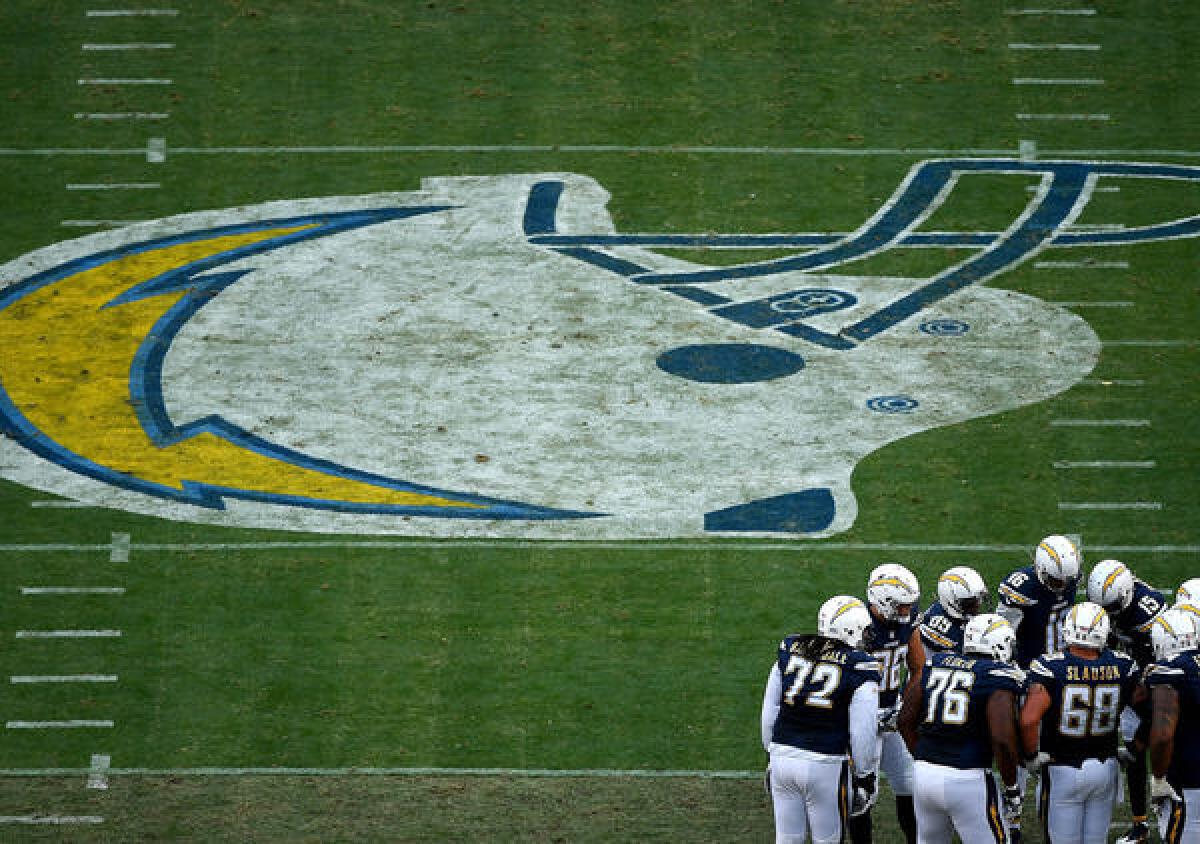
Less than a day after Dean Spanos told NFL officials that he intends to move the Chargers to Los Angeles, the owner is expected to inform the team’s staff of the development in a meeting Thursday morning and visit the new market later in the day.
Spanos informed NFL Commissioner Roger Goodell and several owners Wednesday of his plan to move the team, according to a person with direct knowledge of the situation.
While Spanos hasn’t made the decision official — the move doesn’t need to be approved by league owners — an announcement is expected Thursday.